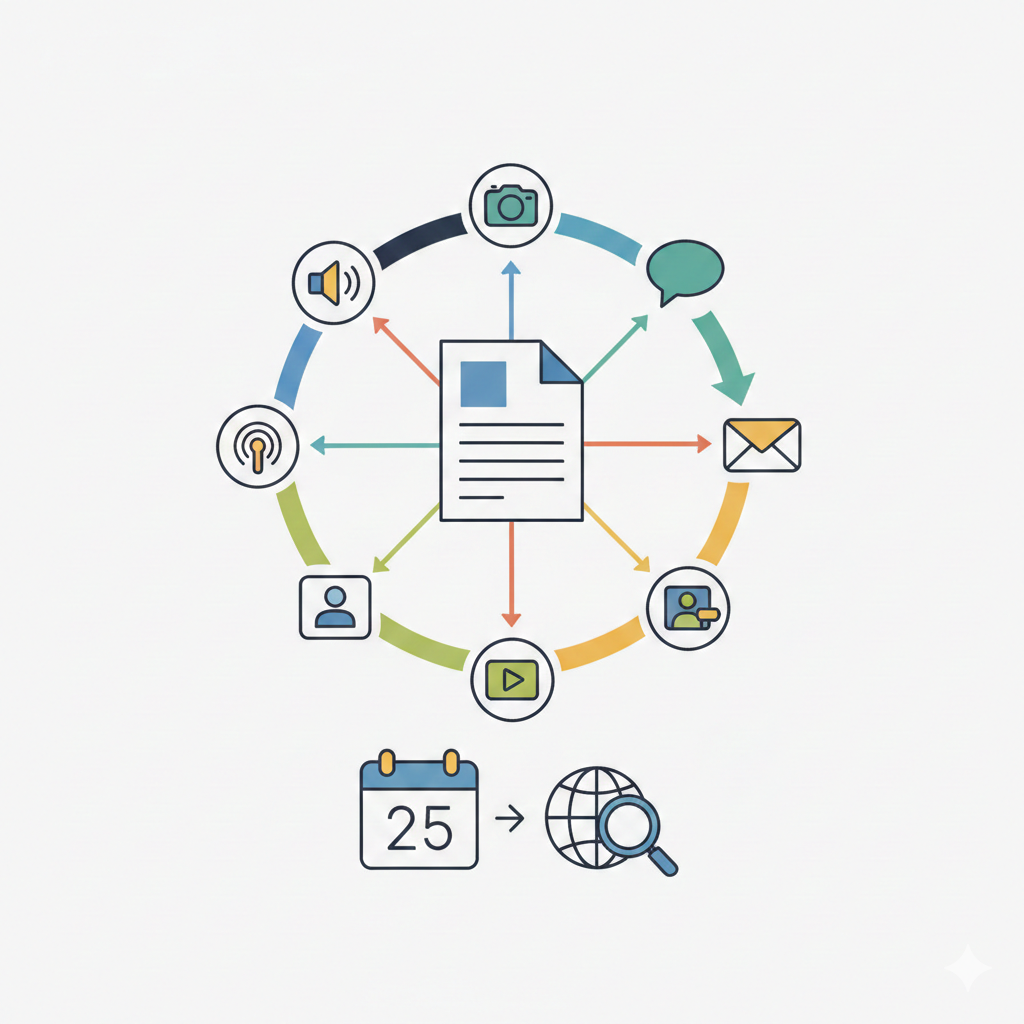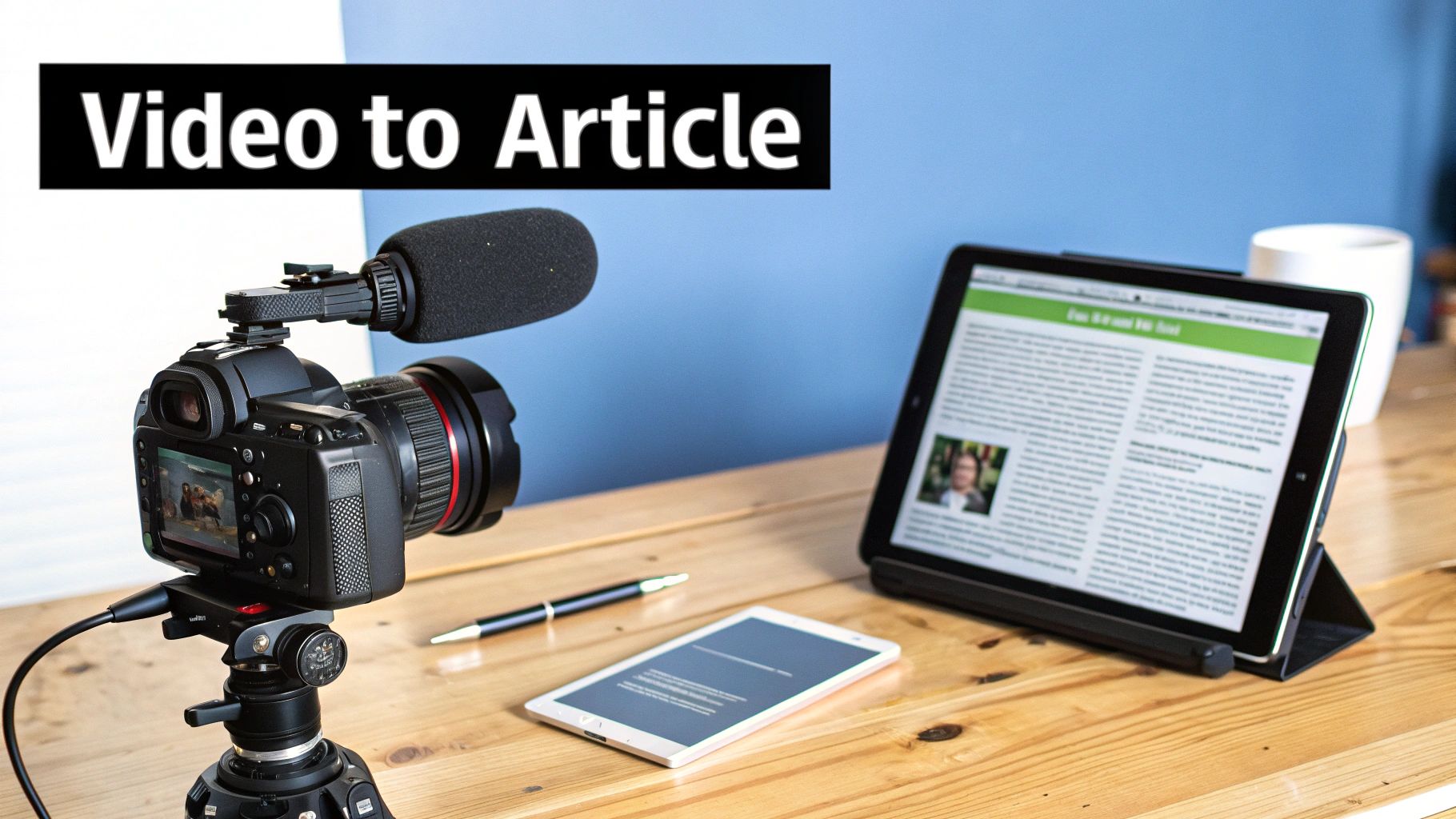10 Smart Content Repurposing Strategies to Scale in 2025

In a world saturated with content, creating more isn't always the answer. The real key to scaling your reach, authority, and engagement lies in working smarter, not harder. This means transforming your best-performing assets into a dynamic ecosystem of content that meets your audience on every channel, from their inbox to their social feeds.
Effective content repurposing strategies don't just save time; they amplify your message, boost SEO by creating topic clusters, and turn a single piece of content into a powerful engine for sustainable growth. By strategically deconstructing and reformatting your proven work, you maximize its value and ensure every insight reaches its full potential audience. This approach is fundamental to building a resilient content marketing program that consistently delivers results without demanding a constant cycle of net-new creation.
This guide moves beyond generic advice like "turn your blog post into a tweet." Instead, it provides a comprehensive roundup of 10 proven frameworks for turning your existing blogs, webinars, social posts, and podcasts into a steady stream of high-value assets. Our focus is on fueling your newsletter and building a cohesive cross-channel distribution plan.
Inside, you'll find actionable tactics, real-world examples, and the exact steps you can take to implement these content repurposing strategies today. Whether you're a small business owner, a solo creator, or part of a B2B marketing team, these frameworks will help you multiply your impact and build a more efficient, powerful content machine.
1. Blog Post to Multimedia Series
One of the most powerful content repurposing strategies involves transforming a single, high-value blog post into a comprehensive multimedia series. Instead of leaving a well-researched article to exist in one format, this approach deconstructs its core concepts and rebuilds them for different platforms and audience preferences. A detailed guide on your blog becomes the source material for an engaging YouTube video, a shareable infographic, a series of podcast episodes, and dozens of social media snippets.
This method magnifies the ROI of your initial content creation effort, ensuring your message reaches visual learners, auditory consumers, and those who prefer quick, scannable text. By distributing the same core value across multiple channels, you meet your audience where they are, reinforcing your authority and brand presence.

How to Implement This Strategy
To effectively convert a blog post into a multimedia powerhouse, start with your most valuable, evergreen content. These comprehensive, long-form articles, often called "pillar posts," provide the richest material for adaptation. For example, a B2B SaaS company could turn a blog post titled "The Ultimate Guide to Customer Retention" into a webinar, a downloadable PDF checklist for their newsletter, and a series of short LinkedIn videos highlighting key statistics from the article.
Actionable Steps:
- Identify Pillar Content: Analyze your blog analytics to find posts with high traffic, engagement, and a long shelf-life. These are your prime candidates.
- Create a Content Atomization Plan: Break down the blog post into its main sections, key takeaways, statistics, and quotes. Map each "atom" to a potential new format.
- Use Accessible Tools: You don't need a full production studio. Tools like Canva are excellent for creating infographics and social media graphics, while Loom or Descript can help you quickly record screen-share videos or generate podcast audio from a script.
- Optimize for Each Channel: Do not simply copy and paste. Adapt the content for the platform. A YouTube video should be visually engaging, an infographic must be concise and data-driven, and a podcast segment should be conversational. Each piece should stand on its own while reinforcing the central theme of the original post.
2. Webinar to Content Cluster
Another highly effective content repurposing strategy is to transform a single webinar into an entire content cluster. A live or pre-recorded webinar is a goldmine of expert insights, Q&A sessions, and detailed explanations that can fuel your content calendar for weeks. Instead of letting the recording gather dust, this approach deconstructs the event into a web of interconnected assets like blog posts, video clips, quote graphics, and email newsletter content.
This method maximizes the value of a high-effort event, turning a one-time broadcast into a long-lasting resource. It caters to different learning styles by offering the same core information in various formats, from in-depth articles for readers to quick video highlights for social media scrollers. By building a content hub around a single webinar topic, you significantly strengthen your topical authority and create multiple new entry points for your audience.
How to Implement This Strategy
To successfully turn a webinar into a content cluster, begin with the end in mind. Before the event, plan the key talking points that can later become standalone pieces of content. For example, a company like Drift might host a webinar on "The Future of Conversational Marketing" and plan to turn each of the five future trends discussed into its own detailed blog post, supported by short video clips from the live presentation embedded within each article.
Actionable Steps:
- Record in High Quality: Ensure your webinar is recorded in high-resolution video and with clear audio. This is crucial for creating professional-looking clips and accurate transcriptions later.
- Timestamp and Transcribe: During the webinar, have a team member create timestamps for key moments, powerful quotes, and audience questions. Afterward, use a transcription service to create a full text version, which becomes the raw material for blog posts and articles.
- Create Highlight Reels: Isolate the most impactful 2-3 minute segments from the webinar. These can be shared on YouTube, LinkedIn, and in your email newsletter to drive traffic back to the full recording or a summary blog post.
- Atomize for Social Media: Extract compelling statistics, quotes, or key takeaways and turn them into branded quote graphics using a tool like Canva. These are perfect for sharing on Instagram, Twitter, and LinkedIn to promote the core concepts of your webinar. Distribute these clips and graphics within 48 hours to capitalize on post-event buzz.
3. Pillar Content to Topic Cluster Model
One of the most strategic content repurposing strategies is transforming your standalone pieces into an interconnected topic cluster. This powerful SEO-focused approach involves creating a central "pillar" page, a comprehensive guide on a broad topic, and surrounding it with "cluster" content, which are more detailed articles addressing specific subtopics related to the pillar. These cluster pieces all link back to the main pillar page, creating a web of internal links that signals topical authority to search engines.
This model allows you to repurpose existing content by organizing it into a logical, high-value architecture. Instead of having disparate blog posts, you create a cohesive resource hub that keeps users on your site longer and dramatically improves your chances of ranking for competitive keywords. By establishing deep expertise on a core subject, you build trust with your audience and position your brand as a definitive source of information.
How to Implement This Strategy
To build a topic cluster, begin by auditing your existing content to identify a broad, high-value topic that aligns with your business goals. For example, a marketing automation company could choose "email marketing" as a pillar topic. They could then repurpose existing smaller articles or create new ones on cluster topics like "email segmentation," "A/B testing subject lines," and "improving email deliverability," all linking back to their comprehensive "Ultimate Guide to Email Marketing" pillar page. This structure is famously championed by companies like HubSpot.
Actionable Steps:
- Identify Core Pillar Topics: Choose 3-5 broad subjects that are fundamental to your niche and have significant search volume. These should be topics you want to own.
- Audit and Map Cluster Content: Review your existing content for articles, guides, or even webinar transcripts that can serve as cluster pieces for each pillar. Aim for 10-15 cluster articles per pillar.
- Establish a Linking Structure: The golden rule is that every cluster page must link back to the pillar page. It's also beneficial to link related cluster pages to one another.
- Maintain and Update: Keep your pillar pages fresh by regularly updating them with new information and linking to newly created cluster content. This signals to search engines that your content is current and authoritative.
4. Email Newsletter Atomization
One of the most underutilized content repurposing strategies involves flipping the traditional content funnel on its head. Instead of creating content for your newsletter, you atomize the newsletter itself into dozens of standalone pieces. Your weekly or monthly email, packed with insights and curated value, becomes the primary source material for a cascade of social media posts, blog snippets, and shareable graphics.
This approach transforms a private communication channel into a public marketing engine. It maximizes the effort invested in crafting high-quality newsletter content by ensuring it reaches audiences on platforms like LinkedIn, Twitter, and Instagram. By deconstructing your newsletter, you can tease its value, attract new subscribers, and reinforce your expertise across multiple digital touchpoints.
How to Implement This Strategy
To effectively atomize your newsletter, you must write it with repurposing in mind from the start. Build your newsletter in modular sections-a key insight, a statistic, a quick tip, or a customer story. Each module can be easily lifted and adapted. For example, Lenny Rachitsky often shares compelling data points and frameworks from his paid newsletter on Twitter and LinkedIn, driving massive engagement and new subscriptions. Similarly, Morning Brew excels at turning its newsletter's witty analysis into highly shareable social media assets.
Actionable Steps:
- Create Modular Sections: Design your newsletter with distinct, self-contained blocks of content. This makes it easy to extract a single idea for a tweet or a key statistic for an infographic.
- Identify High-Value "Atoms": Review your newsletter draft and highlight the most compelling parts. These could be bold predictions, surprising data, actionable tips, or powerful quotes.
- Adapt for Each Platform: Turn a newsletter's main point into a thoughtful LinkedIn post. Convert a list of tips into a Twitter thread or an Instagram carousel. The goal is to reformat, not just copy and paste.
- Always Link Back: Every piece of atomized content should include a clear call-to-action that encourages people to subscribe to your newsletter for more in-depth insights. This closes the loop and fuels list growth. A well-executed atomization plan can greatly benefit from a professional approach; you can explore a newsletter writing service to ensure your content is modular and primed for repurposing from day one.
5. Case Study Expansion Framework
One of the most valuable content repurposing strategies for building trust and driving conversions is the Case Study Expansion Framework. This approach takes a single customer success story and strategically multiplies it into a wide array of content formats. Instead of publishing one case study and moving on, you treat it as a cornerstone asset, deconstructing its narrative, data, and testimonials for different platforms and audiences.
This method transforms a powerful but often underutilized asset into a lead-generation engine. A detailed PDF case study can become the source material for a compelling video interview, a data-rich infographic, a practical webinar, and a stream of quote-based social media posts. This maximizes the ROI of your customer research, ensuring your proof of value reaches prospects at every stage of their journey and in the format they prefer.
How to Implement This Strategy
To effectively expand a case study, begin by conducting a deep-dive interview with your happiest customer, aiming to capture not just results but the entire story. Focus on the "before" state, the challenges they faced, the implementation process, and the specific "after" metrics. This rich source material, popularized by companies like HubSpot and Salesforce, becomes the foundation for all subsequent assets. For example, a B2B software company's written case study on how a client increased efficiency by 40% can be repurposed into a short video testimonial for the homepage, an infographic comparing before-and-after workflows for social media, and a webinar where the client details their implementation journey.
Actionable Steps:
- Capture Rich Source Material: During the case study interview, record video and audio. This provides immediate assets for video testimonials and podcast clips without extra effort.
- Atomize the Narrative: Break the case study down into core components: the problem, the solution, the results, key metrics, and powerful customer quotes. Each component can become a standalone piece of content.
- Create Format-Specific Assets: Use the atomized content to build out your assets. Turn metrics into an infographic using Canva. Edit the video interview into a 2-minute highlight reel for LinkedIn. Use the powerful quotes as text overlays on images for Twitter and Instagram.
- Develop a Distribution Plan: Schedule the rollout of your repurposed assets across different channels over several weeks to maximize reach and impact. You can learn more about how a digital case study framework can enhance this process. Each piece should link back to the full, in-depth case study to drive deeper engagement.
6. Social Media Thread to Long-Form Content
Turning a high-performing social media thread into substantial long-form content is a modern and highly effective content repurposing strategy. This approach takes a validated, bite-sized narrative that has already captured audience attention on platforms like X (formerly Twitter) or LinkedIn and expands it into a comprehensive blog post, a detailed newsletter issue, or even the script for a video. The initial thread acts as a powerful testing ground for ideas, proving audience interest before you invest significant resources.
This method leverages the viral momentum of social media to build deeper, more permanent assets. A thread that goes viral indicates a strong market fit for the topic, and by transforming it into a long-form piece, you capture that fleeting engagement and convert it into lasting SEO value, lead generation opportunities, and a more authoritative resource for your audience.
How to Implement This Strategy
The key to this strategy is to use the original thread as a detailed outline. Each post or tweet in the sequence becomes a section or key point in your new long-form piece. This is where you can add the depth, research, and context that the character limits of social media prevent. For instance, Alex Cattoni of Copy Posse frequently expands her popular marketing threads into detailed blog posts and YouTube videos, adding case studies and deeper explanations to each point.
Actionable Steps:
- Identify Winning Threads: Use your social media analytics to pinpoint threads with the highest engagement, reach, and shares. These are your proven concepts.
- Use the Thread as an Outline: Treat each tweet or post in the thread as a sub-heading. Your task is to flesh out each of these points with more detail.
- Enrich and Expand: Add statistics, research, expert quotes, illustrative examples, and personal anecdotes to transform the concise thread into a valuable, comprehensive resource. The goal is to provide at least 10x more value than the original thread.
- Cross-Promote and Link Back: Once your blog post or video is live, go back to the original social media thread. Reply to it with a link to the new, expanded content to drive your social audience to your owned platforms and capture new traffic from future thread viewers.
7. Video to Article Pipeline
One of the most efficient content repurposing strategies is creating a pipeline to convert video content into high-quality written articles. This approach takes engaging visual media like YouTube videos, webinars, or presentations and transforms them into text-based formats such as blog posts, guides, and even whitepapers. By doing this, you unlock your video's value for text-based search engines and make it accessible to audiences who prefer reading.
This method effectively doubles the reach of your video production efforts, capturing organic search traffic that video platforms alone might miss. It allows you to tap into the SEO power of written content, turning a spoken script into a fully optimized, indexable asset that drives sustained traffic and reinforces your expertise on a topic.

How to Implement This Strategy
To successfully turn video into text, begin with content that is rich in information and structured logically. Educational videos, tutorials, and expert interviews are ideal candidates. For example, a creator like Pat Flynn often converts detailed podcast and video interviews into comprehensive blog posts, capturing the key insights for his reading audience. Similarly, many TED Talks are adapted into written articles that summarize the core message for broader distribution.
Actionable Steps:
- Transcribe Your Video: Use AI-powered services like Otter.ai, Rev, or even YouTube's built-in auto-caption feature to generate a raw text transcript. This is your foundational material.
- Edit for Readability: A direct transcript is often conversational and unstructured. Hire an editor or refine the text yourself to transform it into a well-organized article. Add headings, subheadings, and bullet points to improve flow.
- Optimize for SEO: The transcript is your starting point, not the final product. Conduct keyword research and strategically weave relevant terms into your headlines, body text, and meta description to align with search intent.
- Enhance and Embed: Add screenshots, graphics, and pull quotes from the video to make the article visually engaging. Crucially, embed the original video within the post to provide a multimedia experience and increase time on page. You can even include timestamps that link to specific moments in the video.
8. Research and Data Visualization
One of the most authoritative content repurposing strategies is to transform proprietary research, surveys, and complex data sets into easily digestible visual assets. This approach takes dense, numbers-heavy information and repackages it into compelling infographics, interactive charts, and sharable slide decks. By making complex data accessible and visually appealing, you establish your brand as an industry thought leader and create highly valuable, link-worthy content.
This method extends the life and reach of a single research initiative, turning one data-rich report into dozens of assets. It caters to audiences who prefer scannable visuals over long-form text, increasing the shareability of your key findings across social media, blogs, and press mentions. It's an exceptional way to generate backlinks and boost your domain authority, as other publications will cite your original research.

How to Implement This Strategy
To leverage this strategy, start with a unique data source, such as an annual industry survey or an analysis of your own customer data. Brands like HubSpot excel at this by publishing their annual "State of Marketing" report, which is then repurposed into countless blog posts, infographics, and social media graphics throughout the year. The goal is to make your brand the primary source for important industry statistics.
Actionable Steps:
- Conduct Original Research: Create and distribute a survey to your audience or analyze internal data to uncover unique trends and insights. This positions you as an original source of information.
- Visualize Key Findings: Identify the most surprising or impactful statistics from your research. Use tools like Canva or Infogram to create various visual formats like pie charts, bar graphs, and standalone data callouts.
- Create a Central Hub: Publish the full research in a comprehensive white paper or a detailed blog post. This hub will serve as the core asset that all your smaller visual pieces link back to.
- Atomize for Social Media: Extract single data points and create individual graphics for each one. Share these "micro-infographics" on platforms like LinkedIn, X (formerly Twitter), and Instagram, each linking back to the full report. This is a key part of an effective content repurposing strategy.
9. User-Generated Content Amplification
Amplifying user-generated content (UGC) is one of the most authentic content repurposing strategies available. Instead of creating content from scratch, this approach involves curating, repackaging, and showcasing reviews, testimonials, social media mentions, and customer stories. You transform the voice of your audience into powerful marketing assets like case studies, social proof campaigns, and compelling narratives.
This method builds immense trust and credibility. When prospects see real people celebrating your brand, it serves as powerful, unbiased validation. By systematically collecting and featuring UGC, you create a self-sustaining content engine fueled by your most passionate customers, turning their advocacy into assets that drive conversions and foster community.
How to Implement This Strategy
To effectively leverage UGC, you must create a system for both collecting and republishing it. Begin by encouraging submissions through contests, dedicated hashtags, or simple feedback forms. For example, a brand like GoPro actively features customer videos on its social channels, turning user experiences into thrilling promotional content. Similarly, a B2B software company can compile glowing Trustpilot reviews into a compelling "What Our Customers Say" page or a downloadable PDF case study.
Actionable Steps:
- Establish a Submission System: Create clear, easy ways for customers to share their content, whether through a social media hashtag, an email campaign, or a form on your website.
- Always Get Permission: Before repurposing any user content, reach out and get explicit consent to feature their words or images. This respects your audience and avoids legal issues.
- Curate and Repackage: Don't just reshare. Compile the best reviews into a testimonial video, turn customer photos into a lookbook, or analyze feedback trends for an insightful annual report.
- Tag and Reward Contributors: Acknowledge the original creator whenever you share their content. Tag them on social media and consider offering a small incentive, like a discount or a feature in your newsletter, to encourage future submissions.
10. Podcast to Evergreen Content Series
Transforming episodic podcast audio into a lasting library of evergreen content is a cornerstone of modern content repurposing strategies. This approach takes a time-sensitive, audio-only format and converts it into a variety of persistent, searchable assets. A single hour-long interview can become a detailed blog post, a series of short-form video clips for social media, visually appealing quote graphics, and even a lead-generating email course.
This method dramatically extends the life and reach of your podcast, capturing value long after an episode is published. By converting audio into text and visual formats, you make your content accessible to search engines and audiences who prefer reading or watching. This strategy ensures the insights shared by your guests continue to attract and educate new audience members indefinitely, turning your podcast into a powerful lead-generation engine.
How to Implement This Strategy
Start by treating your podcast not just as an audio show, but as a source of raw intellectual property. Entrepreneurs like Tim Ferriss and Pat Flynn excel at this, systematically turning their popular podcast interviews into comprehensive show notes, blog posts, and social media content. For example, a podcast episode discussing user engagement could be transcribed, with the most valuable insights becoming a blog post. Key quotes can be turned into graphics for Instagram, and a 60-second highlight can be clipped for TikTok or LinkedIn.
Actionable Steps:
- Transcribe Every Episode: Use an AI-powered service like Descript or Otter.ai to get a full text transcript. This is the foundation for all text-based repurposing.
- Extract Key Moments: During the editing process, identify the most impactful quotes, surprising statistics, and actionable takeaways. These are your "content atoms" for social media.
- Create Summary Blog Posts: Write an article summarizing the episode's main themes and key points. Embed the audio player and include the full transcript for SEO benefits.
- Clip Video Highlights: If you record video, create short clips (30-90 seconds) of the most engaging moments. Add captions and share them natively on platforms like LinkedIn, Instagram Reels, and YouTube Shorts.
- Build Content Clusters: Group related podcast episodes by theme and create a "pillar" page or a mini-email course that guides your audience through the topic. This is an excellent way to use a newsletter platform to nurture leads.
10-Strategy Content Repurposing Comparison
| Strategy | Details |
|---|---|
| Blog Post to Multimedia Series | Complexity: Medium. Resources: Moderate (video/audio, design skills). Outcome: Broader reach, higher engagement. Best for: Evergreen posts. Advantage: Consistent messaging. |
| Webinar to Content Cluster | Complexity: High. Resources: High (editors, transcribers). Outcome: Multiple lead magnets, extended ROI. Best for: Product demos, live events. Advantage: Leverages live engagement. |
| Pillar Content to Topic Cluster | Complexity: High. Resources: Moderate-High (writers, SEO). Outcome: Strong topical authority, organic traffic growth. Best for: SEO-driven growth. Advantage: Improves rankings and UX. |
| Email Newsletter Atomization | Complexity: Low. Resources: Low (simple design tools). Outcome: Increased cross-channel reach, signups. Best for: Regular newsletters. Advantage: Low-effort ROI lift. |
| Case Study Expansion Framework | Complexity: Medium-High. Resources: Moderate (interviewers, editors). Outcome: High-conversion social proof. Best for: B2B sales enablement. Advantage: Credibility-rich assets. |
| Social Media Thread to Long-Form | Complexity: Low-Medium. Resources: Low (writing/editing time). Outcome: Converts viral interest to durable assets. Best for: High-engagement posts. Advantage: Validated audience interest. |
| Video to Article Pipeline | Complexity: Medium. Resources: Moderate (transcribers, editors). Outcome: Improved discoverability, accessibility. Best for: Video-first creators. Advantage: Boosts SEO. |
| Research & Data Visualization | Complexity: High. Resources: High (research budget, designers). Outcome: Backlinks, PR opportunities. Best for: Original industry reports. Advantage: Authority-building. |
| UGC Amplification | Complexity: Medium. Resources: Low-Moderate (community management). Outcome: Authentic social proof, improved conversions. Best for: Consumer brands. Advantage: Cost-effective credibility. |
| Podcast to Evergreen Content | Complexity: Medium. Resources: Moderate (transcribers, editors). Outcome: Evergreen searchable assets. Best for: Interview-style podcasts. Advantage: Extends guest reach. |
From Strategy to System: Automating Your Content Engine
You've explored a comprehensive toolkit of ten powerful content repurposing strategies, from transforming a single blog post into a multimedia series to amplifying user-generated content across your channels. Each tactic offers a unique pathway to maximize the value of your core assets, extend your reach, and engage your audience on their preferred platforms. The common thread weaving through all these approaches is a fundamental shift in mindset: seeing every piece of content not as a final destination, but as a starting point for countless new opportunities.
By now, it should be clear that repurposing isn't just about saving time; it's a strategic imperative for modern marketing. It allows you to build authority by reinforcing your message in various formats, cater to diverse learning styles, and dominate search engine results by creating dense, interconnected topic clusters. You're no longer on a content treadmill, constantly chasing the next new idea. Instead, you're building a content ecosystem where every webinar, podcast, case study, and social media thread works synergistically to drive sustainable growth.
Turning Knowledge into Actionable Workflows
The true challenge isn't understanding these strategies, it's implementing them consistently. Moving from an ad-hoc approach to a systematic one is the bridge between good marketing and great marketing. The goal is to build a repeatable, semi-automated engine that reliably extracts and distributes value from your cornerstone content.
Here are your immediate next steps to make these concepts a reality:
- Conduct a Content Audit: Before creating anything new, look back. Identify your top-performing assets from the past year. Which blog posts got the most traffic? Which webinars had the highest engagement? This is your goldmine of repurposing potential.
- Choose Your "Pillar" Strategy: Don't try to implement all ten strategies at once. Select one or two that align perfectly with your existing strengths. If you have a successful podcast, focus on the "Podcast to Evergreen Content Series" model. If you produce in-depth webinars, master the "Webinar to Content Cluster" framework.
- Document Your Process: Create a simple, step-by-step checklist or template for your chosen strategy. Define who is responsible for each step, what tools are needed, and where the new assets will be stored and distributed. This documentation is the foundation of a scalable system. For example, a webinar repurposing checklist might include steps for extracting audio, creating audiograms, transcribing key quotes, and designing a summary infographic.
- Establish Your Measurement Framework: How will you define success? Go beyond vanity metrics. For B2B teams, it might be tracking lead generation from repurposed assets. For creators, it could be measuring audience growth on a new platform or newsletter subscriber engagement rates. Set clear KPIs before you begin.
Scaling Your Content Engine for Maximum Impact
Once you have a proven workflow, the next phase is optimization and scale. This is where you can leverage technology to handle the repetitive, time-consuming tasks, freeing your team to focus on high-level strategy and creativity. To truly streamline your content pipeline and scale your efforts, explore effective strategies for automating content creation processes.
By building a system around these powerful content repurposing strategies, you transform your marketing from a series of disjointed efforts into a cohesive, high-performance engine. You ensure every ounce of effort you invest yields exponential returns, creating a lasting library of assets that continuously attract, engage, and convert your ideal audience. This is how you win in a crowded digital landscape, not by creating more, but by making more of what you create.
Ready to put your content repurposing on autopilot? Potions uses a unique blend of AI and human curation to automatically transform your existing articles, videos, and social posts into a stunning, on-brand newsletter every week. Stop spending hours on manual repurposing and start saving over 10 hours a month with Potions.
Article created using Outrank
